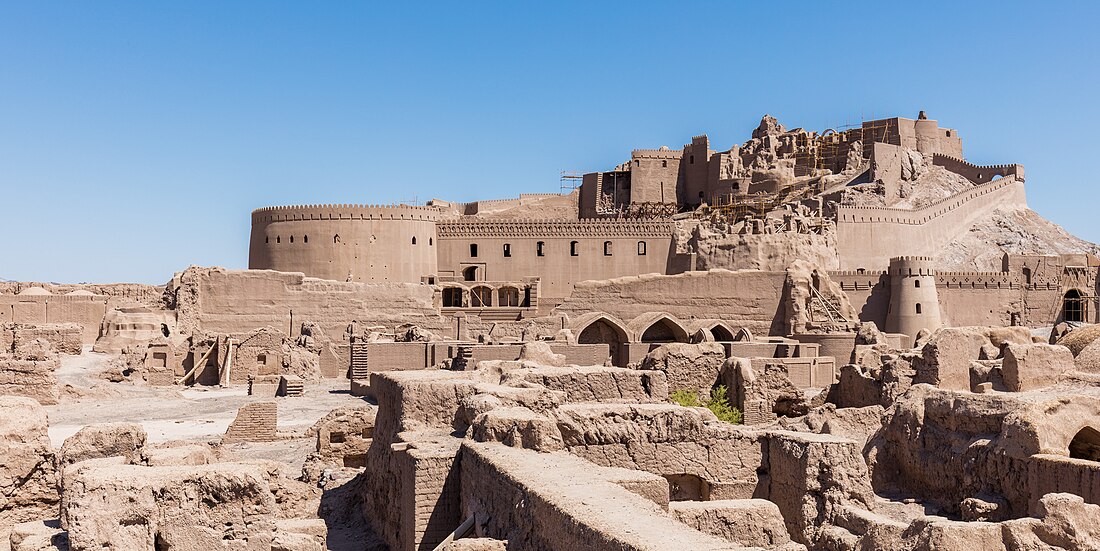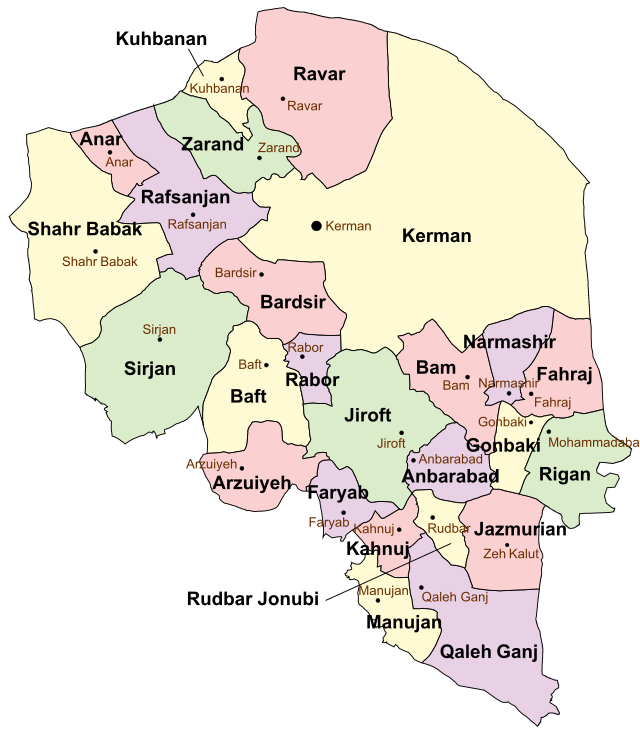Kerman province
Province of Iran From Wikipedia, the free encyclopedia
Kerman province (Persian: استان کرمان)[a] is the largest of the 31 provinces of Iran. Its capital is the city of Kerman.[4]
Kerman Province
Persian: استان کرمان | |
|---|---|
 Bam Fortress (2016) | |
 Location of Kerman province within Iran | |
| Coordinates: 29°13′N 57°26′E[1] | |
| Country | Iran |
| Region | Region 5 |
| Capital | Kerman |
| Counties | 25 |
| Government | |
| • Governor-general | Mohammad Ali Talebi (Independent) |
| Area | |
• Total | 183,285 km2 (70,767 sq mi) |
| Elevation | 192 m (630 ft) |
| Population (2016)[2] | |
• Total | 3,164,718 |
| • Density | 17/km2 (45/sq mi) |
| Time zone | UTC+03:30 (IRST) |
| ISO 3166 code | IR-08 |
| Main language(s) | Persian |
| HDI (2017) | 0.778[3] high · 20th |
| Website | www.gov.kr.ir |
The province is in the southeast of Iran. In 2014 it was placed in Region 5.[5] Mentioned in ancient times as the Achaemenid satrapy of Carmania,[6] Kerman province has an area of 183,285 km2 (70,767 sq mi), encompassing nearly 11% of the land area of Iran.[7]
History
According to a text from the 8th century commontly attributed to the Armenian historian Movses Khorenatsi, present-day Kerman province was situated in the southern quarter of the Sasanian Empire. The main city of the region from the Sasanian era to the 10th century was Sirjan.[8]
Early Muslim geographers considered the area as part of the hot climatic zone and the mountainous interior as home of predatory people including the Kufečs (or Kofejān). Hamdallah Mustawfi stated that predatory beasts roamed the area which by then had undergone forestation.[8]
In the 13th century it came under the rule of the Qutlugh-Khanids founded by ethnic Khitans, than under the Mongol Empire. It was under the Timurid empire in 15th century.
Demographics
Summarize
Perspective
Language
The main languages of Kerman province are Persian and Garmsiri. Smaller languages include Achomi, Turkic dialects and a Median-type dialect spoken by the Jewish and Zoroastrian communities.[9]
The Persian varieties can be considered one single Kermani accent and they are sufficiently close to Standard Persian which they share intelligibility with.[9]
Population
At the time of the 2006 National Census, the province's population was 2,584,834 in 612,996 households.[10] The 2011 census recorded a population of 2,938,988 people (1,482,339 male and 1,456,649 female) in 785,747 households. Urban areas accounted for 1,684,982 people, whereas 1,242,344 lived in rural vicinities; 6,082 were non-residents.[11] The 2016 census measured the population of the province as 3,164,718 in 932,721 households.
The capital city of Kerman, with a population of 537,718, comprises about 29% of the provincial urban population of 1.85 million, being the most developed and largest city of the province.[2]
Administrative divisions
The population history and structural changes of Kerman province's administrative divisions over three consecutive censuses are shown in the following table.
| Counties | 2006[10] | 2011[11] | 2016[2] |
|---|---|---|---|
| Anar[b] | — | 35,295 | 36,897 |
| Anbarabad | 113,751 | 85,942 | 82,438 |
| Arzuiyeh[c] | — | 41,979 | 38,510 |
| Baft | 138,847 | 75,940 | 84,103 |
| Bam | 277,835 | 195,603 | 228,241 |
| Bardsir | 84,543 | 73,738 | 81,983 |
| Fahraj[d] | — | 68,038 | 67,096 |
| Faryab[e] | — | 34,417 | 34,000 |
| Gonbaki[f] | — | — | — |
| Jazmurian[g] | — | — | — |
| Jiroft | 181,300 | 277,748 | 308,858 |
| Kahnuj | 102,269 | 86,290 | 95,848 |
| Kerman | 654,052 | 722,484 | 738,724 |
| Kuhbanan | 24,465 | 21,721 | 21,205 |
| Manujan | 63,270 | 64,528 | 65,705 |
| Narmashir[h] | — | 58,229 | 54,228 |
| Qaleh Ganj | 69,008 | 76,376 | 76,495 |
| Rabor[i] | — | 34,392 | 35,362 |
| Rafsanjan | 291,417 | 287,921 | 311,214 |
| Ravar | 38,539 | 40,295 | 43,198 |
| Rigan[j] | — | 66,335 | 88,410 |
| Rudbar-e Jonubi | 86,747 | 104,421 | 105,992 |
| Shahr-e Babak | 100,192 | 90,495 | 103,975 |
| Sirjan | 239,455 | 267,697 | 324,103 |
| Zarand | 119,144 | 129,104 | 138,133 |
| Total | 2,584,834 | 2,938,988 | 3,164,718 |
Cities
According to the 2016 census, 1,858,587 people (over 58% of the population of Kerman province) live in the following cities:[2]
Most populous cities
The following sorted table, lists the most populous cities in Kerman.[2]
Geography
Summarize
Perspective
The altitudes and heights of the province are the continuation of the central mountain ranges of Iran. They extend from the volcanic folds beginning in Azerbaijan and, by branching out in the central plateau of Iran, terminate in Baluchestan. These mountain ranges have brought about vast plains in the province. The Bashagard and Kuhbonan Mountains are the highest in this region and include peaks such as Toghrol, Aljerd, Palvar, Sirach, Abareq and Tahrood. Other ranges that stretch out from Yazd to Kerman and Challeh-ye-Jazmoorian include high peaks like Hazaran which is 4,501 meters above sea level (ASL), Kuh-e Shah 4,402 meters ASL, Joupar, Bahr Aseman and Khabr mountain in Khabr National Park and others.
Most of the province is largely steppe or sandy desert, although there are some oases where dates, oranges (said to be the best in Iran), and pistachios are cultivated. In antiquity "Carmanian" wine was famed for its quality [Strabo XV.2.14 (cap. 726)]. The province is dependent on qanats (underground water channels) for its irrigation. In the central parts, Mount Hezar is the highest peak, 4501 meters above sea level.
Kerman is prone to natural disasters. A recent flood for example, unearthed the archeological ancient city of Jiroft, in the south of Kerman province. Arg-é Bam on the other hand, the world's largest adobe structure, was destroyed in an earthquake in December 2003. On February 22, 2005, a major earthquake killed hundreds of residents in the town of Zarand and several nearby villages in north Kerman.
Economy
As of 1920, the province was known for the quality of its caraway.[21] Today, Kerman is where a large portion of Iran's auto industry is based. Sirjan, a specially designated economic zone, is considered a passageway for transfer of imported commercial goods from the south (through the Persian Gulf).
Arg e Jadid, is another specially designated economic zone of Iran, located in Kerman province.
Furthermore, Kerman province is famous for its abundance of pistachio fields both in the city itself and surrounding ones such as Rafsanjan, Ravar and Nooq.

The Gol Gohar mine, the largest iron mine in Iran,[22] is located in Kerman province.[23]: 105
Education
Colleges and universities
Kerman province contains the following universities:
See also
- Kirman (Sasanian province)
- Kerman Province parliamentary districts (related to the Islamic Consultative Assembly)
- List of monuments in Kerman Province
- Carmania (satrapy)
- Dalfard
![]() Media related to Kerman Province at Wikimedia Commons
Media related to Kerman Province at Wikimedia Commons
Notes
- Also romanized as Ostān-e Kermān
- Separated from Rafsanjan County after the 2006 census[12]
- Separated from Baft County after the 2006 census[13]
- Separated from Bam County after the 2006 census[14]
- Separated from Kahnuj County after the 2006 census[15]
- Separated from Rigan County after the 2016 census[16]
- Separated from Rudbar-e Jonubi County after the 2016 census[17]
- Separated from Bam County after the 2006 census[18]
- Separated from Baft County after the 2006 census[19]
- Separated from Bam County after the 2006 census[20]
References
External links
Wikiwand - on
Seamless Wikipedia browsing. On steroids.


